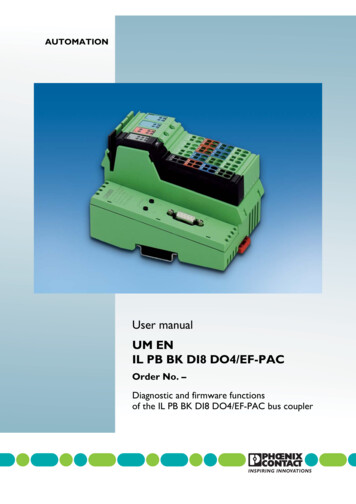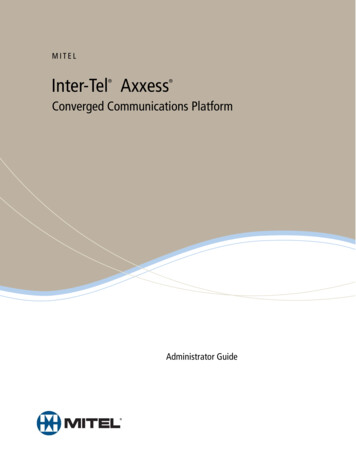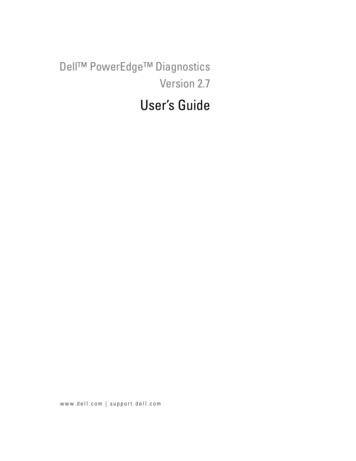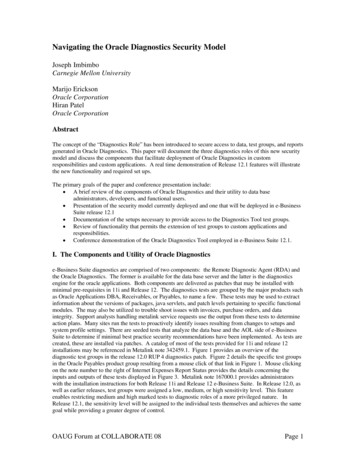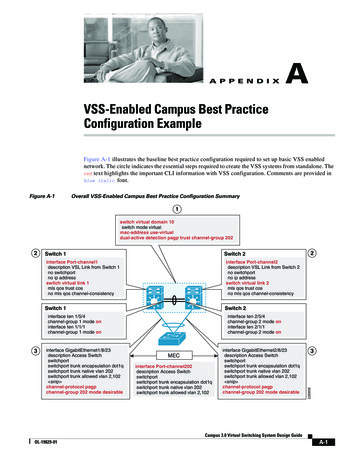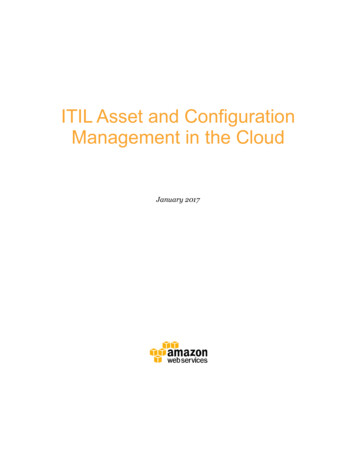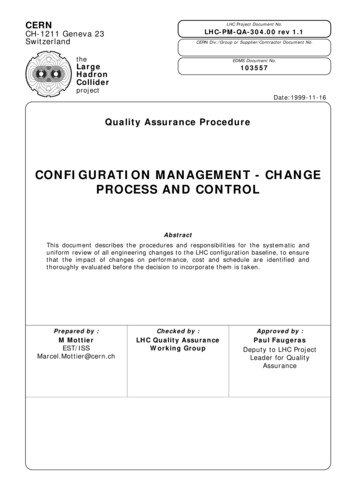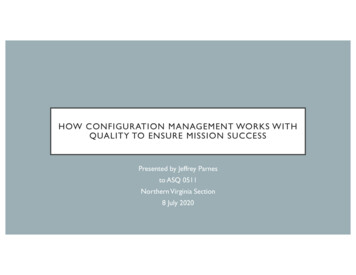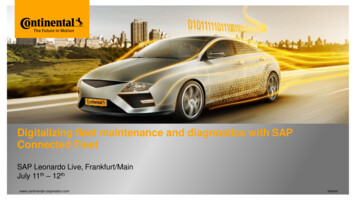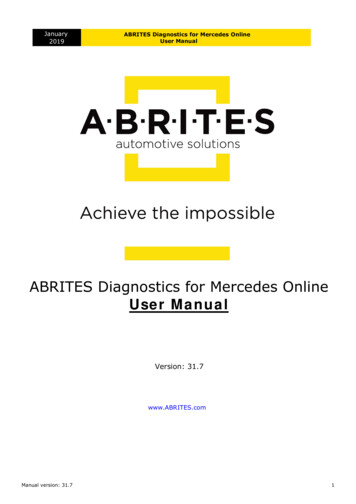
Transcription
Cover SheetConfiguration and Diagnostics of aPROFINET IO SystemPROFINET IO Configuration ExampleApplication Description January 2010Applications & ToolsAnswers for industry.
Industry Automation and Drive Technologies Service & Support PortalThis document is from the Internet service portal of Siemens AG, IndustryAutomation and Drive Technologies. The link below takes you directly to thedownload page of this document.Copyright Siemens AG 2010 All rights iew/en/229811972PROFINET IO ConfigV2.0, ID Number: 22981197
sCopyright Siemens AG 2010 All rights reservedSIMATICPROFINET IO ConfigPROFINET IO ConfigV2.0, ID Number: 22981197Application Description1PROFINET Basics2Installation3Configuration of aPROFINET IO System4Advanced Configuration& Functions5Diagnostics of PROFINETIO Systems6Related literature7History83
Warranty and liabilityWarranty and liabilityNoteThe application examples are not binding and do not claim to be completeregarding the circuits shown, equipping and any eventuality. The applicationexamples do not represent customer-specific solutions. They are only intendedto provide support for typical applications. You are responsible for ensuring thatthe described products are correctly used. These application examples do notrelieve you of the responsibility of safely and professionally using, installing,operating and servicing equipment. When using these application examples, yourecognize that Siemens cannot be made liable for any damage/claims beyondthe liability clause described. We reserve the right to make changes to theseapplication examples at any time without prior notice. If there are any deviationsbetween the recommendations provided in these application examples and otherSiemens publications – e.g. Catalogs – then the contents of the other documentshave priority.We do not accept any liability for the information contained in this document.Copyright Siemens AG 2010 All rights reservedAny claims against us – based on whatever legal reason – resulting from the use ofthe examples, information, programs, engineering and performance data etc.described in this application example shall be excluded. Such an exclusion shallnot apply in the case of mandatory liability, e.g. under the German Product LiabilityAct (“Produkthaftungsgesetz”), in case of intent, gross negligence, or injury of life,body or health, guarantee for the quality of a product, fraudulent concealment of adeficiency or breach of a condition which goes to the root of the contract(“wesentliche Vertragspflichten”). However, claims arising from a breach of acondition which goes to the root of the contract shall be limited to the foreseeabledamage which is intrinsic to the contract, unless caused by intent or grossnegligence or based on mandatory liability for injury of life, body or health. Theabove provisions do not imply a change in the burden of proof to your detriment.It is not permissible to transfer or copy these application examples or excerpts ofthem without first having prior authorization from Siemens Industry Sector inwriting.For questions about this document please use the following e-mail INET IO ConfigV2.0, ID Number: 22981197
Table of ContentsTable of ContentsWarranty and liability. 41Application Description . 71.11.21.32PROFINET Basics . 112.12.22.32.42.53Copyright Siemens AG 2010 All rights reservedSetting the PG/PC interface . 19Creating a new project . 20Hardware configuration of an S7-300 station. 22Integrating the SCALANCE X208 into the PROFINET IO system . 24Hardware configuration of an ET 200S . 26Connecting the ET 200eco PN to PROFINET IO . 28Connecting the IE/PB Link PN IO to PROFINET IO . 30Connecting the ET 200S to the PROFIBUS DP network. 32Connecting IWLAN components to PROFINET IO. 34Creating the user program . 36Assigning the device names . 37Configuring the IWLAN devices . 39Configuring the IWLAN access point . 39Configuring the ET 200pro IWLAN. 43Downloading the project. 45Advanced Configuration & Functions . ng the hardware . 15Installing the software. 17Configuration of a PROFINET IO System. 2.24.135General overview . 11PROFINET real-time communication. 11Functional model . 12Configuration . 13Diagnostics. 14Installation. 153.13.24Overview of the automation task. 7Overview of the automation solution . 7Hardware and software components used. 9Creating the topology . 46Features . 46Instructions . 46Automatic commissioning of a PROFINET IO system. 48Features . 48Instructions . 48Start-Up functions. 51Prioritized Start-Up . 51Fast Start-Up . 52Diagnostics of PROFINET IO Systems . 556.16.1.16.1.26.1.36.26.2.16.2.26.36.3.1PROFINET IO ConfigV2.0, ID Number: 22981197Diagnostics with STEP 7 Basis . 55Enabling the diagnostic function in STEP 7 Basis . 55Diagnostics of a module failure . 56Diagnostics of a cable breakage . 57Diagnostics with the Topology Editor . 59Diagnostics of a module failure . 59Diagnostics of a cable breakage . 61Diagnostics using the Web server of the PROFINET IO controller . 62Enabling the Web server and generating RSE . 625
Table of Contents6.3.26.3.36.3.47Related literature . 697.17.2References . 69Internet links . 69History. 70Copyright Siemens AG 2010 All rights reserved8Starting the Web server. 64Diagnostics of a module failure . 66Diagnostics of a cable breakage . 676PROFINET IO ConfigV2.0, ID Number: 22981197
Application Description1.1 Overview of the automation task1Application Description1.1Overview of the automation taskThe objective of this application is to describe the configuration and diagnosticcapabilities of a PROFINET IO system. In addition, this document describes theintegration of a PROFIBUS line and a wireless subsystem into a PROFINET IOsystem.1.2Overview of the automation solutionDiagrammatic representationCopyright Siemens AG 2010 All rights reservedThe following figure schematically shows the most important components of thesolution:Figure 1-1CPU319-3DP/PNSCALANCE X208STEP 7PN IOsystemPN IOET 200ecoPNIE/PBLinkIE/PBLinkPNIOIOPNET 200S PBET 200SPBDPPBDPW788-1RRPB-DPsubsystemIWLANsubsystemET 200S PBET 200pro IWLANConfigurationIn this case, the PROFINET IO controller is a CPU 319-3PN/DP. As PROFINET IOdevices, the following components are connected to the PN IO system usingEthernet cables: ET 200S with IM 151-3 PN ET 200ecoPN IE/PB Link PN IO W788-1RRPROFINET IO ConfigV2.0, ID Number: 229811977
Application Description1.2 Overview of the automation solutionThese components are connected to the SCALANCE X208 Ethernet switch in astar configuration.Since the IE/PB Link is used as a gateway between PROFINET IO andPROFIBUS, PROFIBUS DP slaves can also be connected via this module. Thismodule is an ET 200S with IM 151-1 Standard.An ET 200pro IWLAN is additionally connected to the W788-1 RR wireless accesspoint as a PN IO device.A PG/PC with Ethernet interface is used as a configuration and programming unit.Main contentsThe following topics are discussed in this application:1. Configuration of the PROFINET IO system as shown in figure 1-12. Fast Start-Up function3. STEP 7 diagnostic functions (incl. Topology Editor)4. Web server diagnostic functionsAdvantages of this solutionCopyright Siemens AG 2010 All rights reservedThe configuration presented here shows you the advantages currently offered byPROFINET:8 Easy and inexpensive connection of a PROFIBUS line to PROFINET IO Increased plant availability due to improved diagnostics Integration of a wireless subsystem Reliable, flexible, expandable, modular solution that is easy to maintainPROFINET IO ConfigV2.0, ID Number: 22981197
Application Description1.3 Hardware and software components used1.3Hardware and software components usedThe application was created using the following components:Hardware componentsTable 1-1Copyright Siemens AG 2010 All rights reservedComponentNo.MLFB/order numberS7-300 mounting rail16ES7 390-1AE800AA0PS307 5Apower supply26ES7 307-1EA00-0AA0CPU 319-3PN/DP16ES7 318-3EL00-0AB064 kB Micro MemoryCard (or larger)16ES7 953-8LF20-0AA0ET 200eco PN16ES7 142-6BF00-0AB0SCALANCE X20816GK5 208-0BA10-2AA3IE/PB Link PN IO16GK1 411-5AB00SCALANCE W788-1 RR16GK5 788-1AA60-6AA0IM 151-3PNinterface module16ES7 151-3AA23-0AB0PM-E 24 V DCpower module16ES7 138-4CA01-0AA0Digital input modulefor ET200S 4 DI24 V DC16ES7 131-4BD01-0AA0Digital output modulefor ET200S/ 4 DO24 V DC/0.5 A16ES7 132-4BD02-0AA0Terminal module forpower modules16ES7 193-4CD30-0AA0Terminal module forelectronic modules26ES7 193-4CB20-0AA0NoteV2.8 and higher8 D0, V6.0 and higherET 200S:V6.0 and higherET 200pro IWLAN:Module carrier, narrowfor ET 200PRO,LENGTH: 500 MM6ES7 194-4GA00-0AA0IM 154-6 PN HFIWLANinterface module16ES7 154-6AB00-0AB0EM 142, 8 DO 24Velectronic module16ES7 142-4BF00-0AA0Connection modulefor digital electronicmodules16ES7 194-4CB00-0AA0PROFINET IO ConfigV2.0, ID Number: 229811979
Application Description1.3 Hardware and software components usedComponentNo.MLFB/order numberNoteET200S PROFIBUS:IM 151-1 Standardinterface module16ES7 151-1AA04-0AA0PM-E 24 V DCpower module16ES7 138-4CA01-0AA0Digital input modulefor ET200S 2 DO24 V DC/0.5 A16ES7 132-4BB00-0AA0Terminal modules forpower modules16ES7 193-4CD20-0AA0Terminal modules forelectronic modules16ES7 193-4CA30-0AA0IE FC M12 Plug PRO16GK1 901-0DB20-6AA0IE FC RJ45 PLUG96GK1 901-1BB10-2AA0Cables:Copyright Siemens AG 2010 All rights reservedIE FC TP STANDARDCABLE6XV1 840-2AH10IE FC stripping tool16GK1 901-1GA00PROFIBUS connectingcable terminated 1.5 m16XV1830-1CH15Power Plug Pro16GK1 907-0AB10-6AA0IE Power M12 CableConnector pro16GK1907-0DC10-6AA3Sold by the meterStandard software componentsTable 1-2ComponentSTEP 7 V5.4 SP510No.1MLFB/order number6ES7 810-4CC08-0YA5NoteOr higher versionPROFINET IO ConfigV2.0, ID Number: 22981197
PROFINET Basics2.1 General overviewPROFINET Basics2.12General overviewLike the PROFIBUS field bus, PROFINET technology is standardized anddeveloped by the PROFIBUS user organization.PROFINET differentiates between two applications: PROFINET CBA (Component Based Automation)this version – which was developed first – defines the cross-vendorcommunication of intelligent automation components and plant parts at thecontrol level. Instead of programming the communication between controllers,it is configured using the SIMATIC iMAP interconnection editor. PROFINET IOdefines the connection of distributed field devices to central controllers viaEthernet and the cyclic transmission of I/O data.Copyright Siemens AG 2010 All rights reservedOne of the main challenges for the development of PROFINET was to use Ethernetand other proven IT technologies in all fields of automation.Since its introduction, the PROFINET standard has managed to advance to thefield bus level based on Ethernet, also enabling the transparent integration ofexisting field bus systems – for example, PROFIBUS. The essential advantagesinclude: Integrated communication is achieved and interfaces are reduced Engineering is simplified Diagnostics are simplified Use of the existing know-how and protection of investments that have alreadybeen madeDue to these advantages, the IT world and the automation world grow closertogether.2.2PROFINET real-time communicationCommunication is scalable and three performance levels with different responsetimes are available: TCP/IP (100 ms): For open TCP communication (e.g., for the transmission ofnon-time-critical data: Parameterization, diagnostics) RT (10 ms): Real-time communication for time-critical data (for example, infactory automation: Cyclic data, event-controlled messages, alarms) IRT (1 ms): Isochronous real-time for sophisticated applications (e.g., inmotion control)PROFINET IO ConfigV2.0, ID Number: 2298119711
PROFINET Basics2.3 Functional modelFigure 2-2Copyright Siemens AG 2010 All rights reserved2.3Functional modelThe functional model for PROFINET IO resembles the PROFIBUS DP model, butthe master-slave method was converted into a provider-consumer model since allnodes have equal rights when using Ethernet. The devices of PROFINET IO arereferred to as IO controller and IO device or IO supervisor.Table 2-3Device typeDescriptionIO controllerMaster for the input/output data of the field devices. Represents thecommunications interface of a controller.Corresponds to DP Master Class 1.IO deviceDistributed field device.IO supervisorName for an engineering and diagnostic station. Corresponds to DPMaster Class 2.12PROFINET IO ConfigV2.0, ID Number: 22981197
PROFINET Basics2.4 ConfigurationFigure 2-3 KonfigurationKonfiguration E/A-DatenE/A-Daten FeldgerätIO-DevicePG/PCIO-Supervisor agnoseExisting field bus systems can be easily integrated into PROFINET. This is realizedusing a proxy; this proxy is either integrated in a PROFINET device or it is anindependent device (e.g., SIMATIC NET IE PB Link PN IO).Copyright Siemens AG 2010 All rights reserved2.4ConfigurationPlant engineering requires the device-specific system data (GSD-XML files) of theused field devices (analogously to PROFIBUS DP). It is imported to theconfiguration tool (e.g., STEP7), which, based on the network data, creates anaddress list for the IO controller. The planner assigns a unique logical name toeach field device. The actual name assignment in the device is performed by theDCP (Discovery and Control Protocol) integrated in each IO device.To ensure that each device is detected as a node on the Ethernet, an IP addresshas to be assigned to each device. The IP addresses are generated by theconfiguration tool and downloaded to the IO controller as the configuration.During system startup, the controller assigns these configured IP addresses to theconfigured field devices.This is demonstrated by the schematic diagram below.PROFINET IO ConfigV2.0, ID Number: 2298119713
PROFINET Basics2.5 DiagnosticsCopyright Siemens AG 2010 All rights reservedFigure 2-42.5DiagnosticsPROFINET offers a powerful integrated diagnostic concept that comprises alldevices configured in PROFINET (including the network components that arePROFINET devices, for example SCALANCE X208).Device diagnostics are divided into three levels: Error on the device: Failure of a station Error on the slot: Defect of an individual module Channel error: For example, wire breakIf an error occurs, the relevant IO device generates a diagnostic interrupt that isreported to the controller. The user is responsible for its evaluation.This diagnostic information can be read out and evaluated by a programming unitin the following diagnostics views:14 STEP 7 Basis diagnostics Diagnostics with the Topology Editor Diagnostics using the Web server of the PROFINET IO controllerPROFINET IO ConfigV2.0, ID Number: 22981197
Installation3.1 Installing the hardware3Installation3.1Installing the hardwareFor the hardware components, please refer to chapter 1.3. For the hardwareconfiguration, please follow the instructions listed in the following table:!Do not switch on the power supply until after the last step.AttentionTable 3-4Copyright Siemens AG 2010 All rights reservedNo.FocusAction1.CPU 319-3 PN/DPInsert the MMC into the MMC slot of the CPU 319-3 PN/DP.2.S7-300 mounting railMount the following devices on the S7-300 mounting rail: PS CPU 319-3 PN/DP IE/PB Link PN IO SCALANCE W 788-1RR3.ET 200S(IM 151-3 PN)As described in guide /3/, assemble the following modules in thefollowing order:1. IM151-3 PN interface module2. Terminal module for power modules3. 2 x terminal modules for electronic modules4. Terminating moduleInsert the following modules into the now available terminal modulesin the same order:1. PM-E 24 V DC2. DI 24 V DC ST3. DO 24 V/0.5 A ST4.ET 200S(IM 151-1)As described in guide /3/, assemble the following modules in thefollowing order:1. IM151-1 interface module2. Terminal module for power modules3. Terminal module for electronic modules4. Terminating moduleInsert the following modules into the now available terminal modulesin the same order:1. PM-E 24 V DC2. DO 24 V/0.5 A ST5.35 mm standardmounting railMount the following devices on the 35 mm standard mounting rail:PROFINET IO ConfigV2.0, ID Number: 22981197 SCALANCE X208 ET 200S (IM 151-3 PN) ET 200S (IM 151-1)15
Installation3.1 Installing the hardwareFigure 3-5CPU319-3DP/PNET 200SP1P5P2P6P3P7P4P8W788-1RRSCALANCE X208ET 200ecoPNIE/PB LinkPN IOCopyright Siemens AG 2010 All rights reservedPB DPET 200pro IWLANET 200S PBTable 3-5No.1.FocusPower cablesActionAs described in guides /4/, /5/, /6/, prepare the power cables for thefollowing devices. ET 200eco PN ET 200pro IWLAN SCALANCE W 788-1RR2.Ethernet & PROFIBUScablesPrepare the Ethernet and PROFIBUS cables as described inthe guide.3.Industrial EthernetcablingCable the system as follows:Connect the devices to the SCALANCE X208 Ethernet switch asshown in figure 3-5.4.PROFIBUS cablingConnect the ET 200S IM 151-1 to the IE/PB LINK PN IO viaPROFIBUS.5.Electrical connections Note16Connect the output signals to the inputs of the ET 200S.Connect several output signals to the inputs of the electronicblock of the ET 200S COMPACT.Supply all necessary voltage points with 24 V voltage from thePS.The installation guidelines for Industrial Ethernet networks, ET200 andS7-300 must always be observed.PROFINET IO ConfigV2.0, ID Number: 22981197
Installation3.2 Installing the software3.2Installing the softwareThe table below contains the necessary standard software packages and theadvisable or necessary extensions for STEP7.Table 3-6No.Standard software1.STEP 7 V 5.4 SP 52.HW update / HSP3.GSD XML filesComment / linkTo configure the S7-300 station and program the userprogram.Install the most current HW updates online or via the HSPon the Internet. See \1\.Install the current GSD / XML files as described in manual/7/:Copyright Siemens AG 2010 All rights reservedET 200S if required, see \2\.SCALANCE (necessary for this document) , see \3\.PROFINET IO ConfigV2.0, ID Number: 2298119717
Configuration of a PROFINET IO System3.2 Installing the softwareConfiguration of a PROFINET IOSystem4This chapter describes the configuration of the complete PROFINET IO system.For this purpose, a new project is created, the hardware of an S7-300 (PN IOcontroller) is configured and the PN IO devices are connected to PROFINET.Table 4-7Copyright Siemens AG 2010 All rights reservedDevice18ChapterCommentS7-3004.3SCALANCE X2084.4ET 200S4.5ET 200eco PN4.6IE/PB Link PN IO4.7ET 200S PROFIBUS4.8The ET 200S PB is connected to PROFINETIO via the IE/PB Link PN IO.ET 200pro IWLAN /SCALANCE W4.9The ET 200pro IWLAN is connected toPROFINET IO via the SCALANCE W IWLANAccess Point.IWLAN configuration4.12This chapter describes the configuration forthe wireless connection of the IWLAN devices.PROFINET IO ConfigV2.0, ID Number: 22981197
Configuration of a PROFINET IO System4.1 Setting the PG/PC interface4.1Setting the PG/PC interfaceThe following section describes the basic settings of the PG/PC interface. The“Set PG/PC Interface” dialog box can be accessed within STEP7 and via the menutree.Table 4-8No.ActionOpen the SIMATIC Manager byselecting Start- SIMATIC- SIMATIC Manager.2.Open the window with thePG/PC-interface settings byselecting Options - SetPG/PC InterfaceSelect the network card you areusing.Confirm the setting with OK.Copyright Siemens AG 2010 All rights reserved1.CommentPROFINET IO ConfigV2.0, ID Number: 2298119719
Configuration of a PROFINET IO System4.2 Creating a new project4.2Creating a new projectThis section describes the creation of a new project within STEP7.Table 4-9Copyright Siemens AG 2010 All rights reservedNo.Action3.In the SIMATIC Manager, createa new project by selectingFile - New.4.Enter a name for the project andconfirm it by clicking on OK.20CommentPROFINET IO ConfigV2.0, ID Number: 22981197
Configuration of a PROFINET IO System4.2 Creating a new projectNo.ActionInsert a new station by selectingInsert - Station - SIMATIC 300 Station.6.Inserting the S7-300 station hasnow been completed.Copyright Siemens AG 2010 All rights reserved5.CommentPROFINET IO ConfigV2.0, ID Number: 2298119721
Configuration of a PROFINET IO System4.3 Hardware configuration of an S7-300 station4.3Hardware configuration of an S7-300 stationThe following step sequence describes the procedure for configuring an S7-300station with a CPU 319-3 PN/DP for a PROFINET IO connection.Table 4-10Copyright Siemens AG 2010 All rights reservedNo.Action1.Open HW Config by doubleclicking on the SIMATIC 300station and then on Hardware.2.You can use the hardwarecatalog to insert your hardwarecomponents.If no catalog is displayed,activate it using theView - Catalog menucommand.3.In the hardware catalog, firstnavigate via SIMATIC 300 - RACK-300- Rail. Now usedrag & drop to move themounting rail to the top left partof the HW Config window.Subsequently, go to PS-300 andinsert the power supply you areusing into slot 1 of the mountingrail.CommentNote: Inserting the power supplyinto the hardware configurationis optional.22PROFINET IO ConfigV2.0, ID Number: 22981197
Configuration of a PROFINET IO System4.3 Hardware configuration of an S7-300 stationNo.4.ActionCommentNow navigate to CPU-300 andto CPU 319-3 PN/DP. Usedrag & drop to move the modulewith version 2.8 (V 2.8) to slot2.Note: Please make sure that theorder numbers of the modulesmatch!The window with the Ethernetproperties of the CPU opens.Enter the desired IP address andclick on New to create a newIndustrial Ethernet subnet. Usethe suggested entries andconfirm all windows with OK.6.The CPU has been inserted intothe S7 controller with PROFINETIO network.Copyright Siemens AG 2010 All rights reserved5.PROFINET IO ConfigV2.0, ID Number: 2298119723
Configuration of a PROFINET IO System4.4 Integrating the SCALANCE X208 into the PROFINET IO system4.4Integrating the SCALANCE X208 into the PROFINET IOsystemAn advantage of the PROFINET architecture is that PROFINET-capablenetwork infrastructures, such as the SCALANCE X200 switches, can beintegrated into PROFINET IO diagnostics.In the following table, a SCALANCE X208 is inserted as a PROFINET IOdevice. This function is optional.Table 4-11Copyright Siemens AG 2010 All rights reservedNo.Action1.In the hardware catalog,navigate toPROFINET IO - NetworkComponents - SCALANCEX-200 - SCALANCE X208Select order number and versionof your switch.2.Use drag & drop to move it to thePROFINET network.24CommentPROFINET IO ConfigV2.0, ID Number: 22981197
Configuration of a PROFINET IO System4.4 Integrating the SCALANCE X208 into the PROFINET IO systemCopyright Siemens AG 2010 All rights reservedNo.Action3.Double-click on the module toopen the Properties dialog box ofthe module. In this dialog box,you can enter the device name, the GSD XML file to beused and the IP address to beassigned.4.To change the device name,enter the new name inDevice Name.5.Use the Change ReleaseNumber button to select theGSD XML file to be used by thesystem. It is recommended thatthe most current version beused. Close the window with OK.6.Use theEthernet button to enter the IP address ofthe SCALANCE X208. Thesystem specifies a free IPaddress in the STEP7 project, itcan be adjusted as desired. Theaddress is dynamically assignedduring startup of the controller.Close the dialog boxes with OK.PROFINET IO ConfigV2.0, ID Number: 22981197Comment25
Configuration of a PROFINET IO System4.5 Hardware configuration of an ET 200S4.5Hardware configuration of an ET 200SLike PROFIBUS DP slaves, PROFINET IO devices are assigned to the networkand thus to the controller in the hardware configuration.This section describes the configuration of an ET 200S PN within a PROFINET IOnetwork.Table 4-12No.ActionFrom the hardware catalog,select the IM151-3 PN modulewith the order number from thecatalog viaPROFINET IO - I/O - ET 200S.2.Use drag & drop to insert thishead module into the PROFINETline.Copyright Siemens AG 2010 All rights reserved1.Comment26PROFINET IO ConfigV2.0, ID Number: 22981197
Configuration of a PROFINET IO System4.5 Hardware configuration of an ET 200SNo.ActionClick on your IM and from thesubmenu in the tree insert theET 200S modules you are usinginto the respective slots. Seealso chapter 1.3 of thisdocument.4.Double-click on the IM 151-3station to open the Propertieswindow of the head module.In this window, you can adjustthe IP address or the devicename. The device nameIM151-3PNHFis used here.Confirm with OK.Copyright Siemens AG 2010 All rights reserved3.!AttentionCommentEach device name, both the controller and the device, must be uniquenetwork-wide! Two devices must not use the same device name.PROFINET IO ConfigV2.0, ID Number: 2298119727
Configuration of a PROFINET IO System4.6 Connecting the ET 200eco PN to PROFINET IO4.6Connecting the ET 200eco PN to PROFINET IOThe procedure for connecting the ET 200eco PN to PROFINET IO is the same asfor the ET 200S PN station.Table 4-13Copyright Siemens AG 2010 All rights reservedNo.Action1.From the hardware catalog inPROFINET IO - I/O - ET 200eco PN, select themodule with the order number.2.Use drag & drop to insert thismodule into the PROFINET line.28CommentPROFINET IO ConfigV2.0, ID Number: 22981197
Configuration of a PROFINET IO System4.6 Connecting the ET 200eco PN to PROFINET IONo.CommentDouble-click on the module toopen the Properties window.In this window, you can adjustthe IP address or theDevice name.The device nameET200ecoPN-DOis used here.Copyright Siemens AG 2010 All rights reserved3.ActionPROFINET IO ConfigV2.0, ID Number: 2298119729
Configuration of a PROFINET IO System4.7 Connecting the IE/PB Link PN IO to PROFINET IO4.7Connecting the IE/PB Link PN IO to PROFINET IOThe connection of existing PROFIBUS components, here PROFIBUS DP slaves, toa PROFINET network requires links with proxy functionality. The IE/PB Link PN IOis such a link. The following steps are necessary to connect the link to thePROFINET IO system.Table 4-14Copyright Siemens AG 2010 All rights reservedNo.Action1.In the hardware catalog,navigate toPROFINET IO - Gateway IE/PB Link PN IO - 6GK1 411-5AB00Select version 2.1 (V 2.1) anduse
A PG/PC with Ethernet interface is used as a configuration and programming unit. Main contents The following topics are discussed in this application: 1. Configuration of the PROFINET IO system as shown in figure 1-1 2. Fast Start-Up function 3. STEP 7 diagnostic functions (incl. Topology Editor) 4. Web server diagnostic functions
